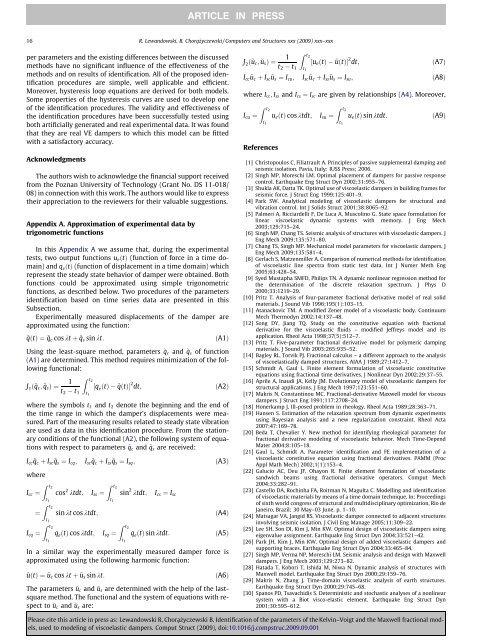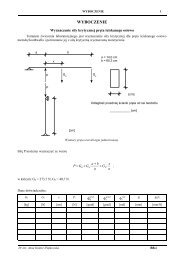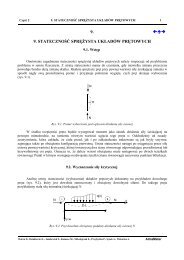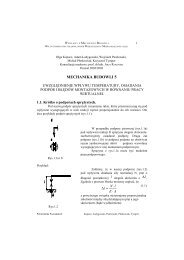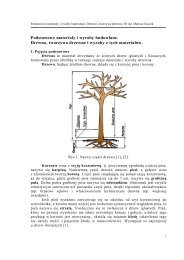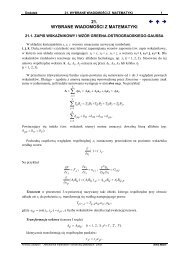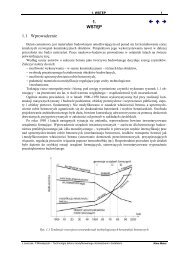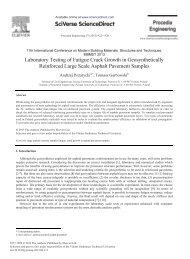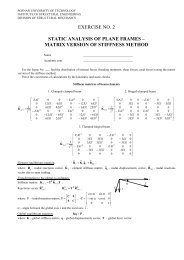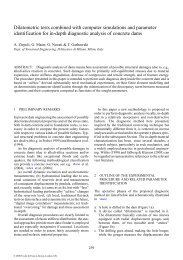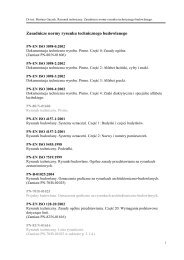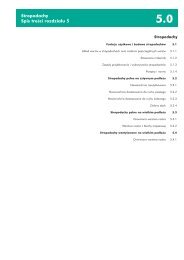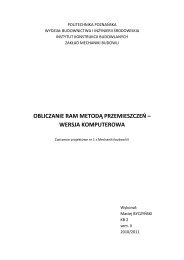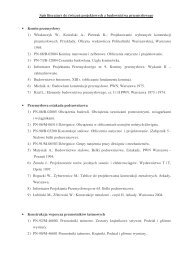Identification of the parameters of the Kelvin–Voigt and the Maxwell ...
Identification of the parameters of the Kelvin–Voigt and the Maxwell ...
Identification of the parameters of the Kelvin–Voigt and the Maxwell ...
Create successful ePaper yourself
Turn your PDF publications into a flip-book with our unique Google optimized e-Paper software.
ARTICLE IN PRESS<br />
16 R. Lew<strong>and</strong>owski, B. Chorą_zyczewski / Computers <strong>and</strong> Structures xxx (2009) xxx–xxx<br />
per <strong>parameters</strong> <strong>and</strong> <strong>the</strong> existing differences between <strong>the</strong> discussed<br />
methods have no significant influence <strong>of</strong> <strong>the</strong> effectiveness <strong>of</strong> <strong>the</strong><br />
methods <strong>and</strong> on results <strong>of</strong> identification. All <strong>of</strong> <strong>the</strong> proposed identification<br />
procedures are simple, well applicable <strong>and</strong> efficient.<br />
Moreover, hysteresis loop equations are derived for both models.<br />
Some properties <strong>of</strong> <strong>the</strong> hysteresis curves are used to develop one<br />
<strong>of</strong> <strong>the</strong> identification procedures. The validity <strong>and</strong> effectiveness <strong>of</strong><br />
<strong>the</strong> identification procedures have been successfully tested using<br />
both artificially generated <strong>and</strong> real experimental data. It was found<br />
that <strong>the</strong>y are real VE dampers to which this model can be fitted<br />
with a satisfactory accuracy.<br />
Acknowledgments<br />
The authors wish to acknowledge <strong>the</strong> financial support received<br />
from <strong>the</strong> Poznan University <strong>of</strong> Technology (Grant No. DS 11-018/<br />
08) in connection with this work. The authors would like to express<br />
<strong>the</strong>ir appreciation to <strong>the</strong> reviewers for <strong>the</strong>ir valuable suggestions.<br />
Appendix A. Approximation <strong>of</strong> experimental data by<br />
trigonometric functions<br />
In this Appendix A we assume that, during <strong>the</strong> experimental<br />
tests, two output functions u e ðtÞ (function <strong>of</strong> force in a time domain)<br />
<strong>and</strong> q e ðtÞ (function <strong>of</strong> displacement in a time domain) which<br />
represent <strong>the</strong> steady state behavior <strong>of</strong> damper were obtained. Both<br />
functions could be approximated using simple trigonometric<br />
functions, as described below. Two procedures <strong>of</strong> <strong>the</strong> <strong>parameters</strong><br />
identification based on time series data are presented in this<br />
Subsection.<br />
Experimentally measured displacements <strong>of</strong> <strong>the</strong> damper are<br />
approximated using <strong>the</strong> function:<br />
~qðtÞ ¼~q c cos kt þ ~q s sin kt:<br />
ðA1Þ<br />
Using <strong>the</strong> least-square method, <strong>parameters</strong> ~q c <strong>and</strong> ~q s <strong>of</strong> function<br />
(A1) are determined. This method requires minimization <strong>of</strong> <strong>the</strong> following<br />
functional:<br />
J 1 ð~q c ; ~q s Þ¼ 1<br />
t 2<br />
Z t2<br />
½q<br />
t e ðtÞ ~qðtÞŠ 2 dt; ðA2Þ<br />
1 t 1<br />
where <strong>the</strong> symbols t 1 <strong>and</strong> t 2 denote <strong>the</strong> beginning <strong>and</strong> <strong>the</strong> end <strong>of</strong><br />
<strong>the</strong> time range in which <strong>the</strong> damper’s displacements were measured.<br />
Part <strong>of</strong> <strong>the</strong> measuring results related to steady state vibration<br />
are used as data in this identification procedure. From <strong>the</strong> stationary<br />
conditions <strong>of</strong> <strong>the</strong> functional (A2), <strong>the</strong> following system <strong>of</strong> equations<br />
with respect to <strong>parameters</strong> ~q c <strong>and</strong> ~q s are received:<br />
I cc<br />
~q c þ I sc<br />
~q s ¼ I cq ; I sc<br />
~q c þ I ss<br />
~q s ¼ I sq ; ðA3Þ<br />
where<br />
I cc ¼<br />
¼<br />
I cq ¼<br />
Z t2<br />
t 1<br />
cos 2 ktdt; I ss ¼<br />
Z t2<br />
Z t2<br />
t 1<br />
sin 2 ktdt; I cs ¼ I sc<br />
t 1<br />
sin kt cos ktdt; ðA4Þ<br />
Z t2<br />
t 1<br />
q e ðtÞ cos ktdt; I sq ¼<br />
Z t2<br />
t 1<br />
q e ðtÞ sin ktdt: ðA5Þ<br />
In a similar way <strong>the</strong> experimentally measured damper force is<br />
approximated using <strong>the</strong> following harmonic function:<br />
~uðtÞ ¼~u c cos kt þ ~u s sin kt:<br />
ðA6Þ<br />
The <strong>parameters</strong> ~u c <strong>and</strong> ~u s are determined with <strong>the</strong> help <strong>of</strong> <strong>the</strong> lastsquare<br />
method. The functional <strong>and</strong> <strong>the</strong> system <strong>of</strong> equations with respect<br />
to ~u c <strong>and</strong> ~u s are:<br />
J 2 ð~u c ; ~u s Þ¼ 1 Z t2<br />
½u e ðtÞ ~uðtÞŠ 2 dt; ðA7Þ<br />
t 2 t 1 t 1<br />
I cc<br />
~u c þ I sc<br />
~u s ¼ I cu ; I sc<br />
~u c þ I ss<br />
~u s ¼ I su ; ðA8Þ<br />
where I cc ; I ss <strong>and</strong> I cs ¼ I sc are given by relationships (A4). Moreover,<br />
Z t2<br />
Z t2<br />
I cu ¼ u e ðtÞ cos ktdt; I su ¼ u e ðtÞ sin ktdt: ðA9Þ<br />
t 1 t 1<br />
References<br />
[1] Christopoulos C, Filiatrault A. Principles <strong>of</strong> passive supplemental damping <strong>and</strong><br />
seismic isolation. Pavia, Italy: IUSS Press; 2006.<br />
[2] Singh MP, Moreschi LM. Optimal placement <strong>of</strong> dampers for passive response<br />
control. Earthquake Eng Struct Dyn 2002;31:955–76.<br />
[3] Shukla AK, Datta TK. Optimal use <strong>of</strong> viscoelastic dampers in building frames for<br />
seismic force. J Struct Eng 1999;125:401–9.<br />
[4] Park SW. Analytical modeling <strong>of</strong> viscoelastic dampers for structural <strong>and</strong><br />
vibration control. Int J Solids Struct 2001;38:8065–92.<br />
[5] Palmeri A, Ricciardelli F, De Luca A, Muscolino G. State space formulation for<br />
linear viscoelastic dynamic systems with memory. J Eng Mech<br />
2003;129:715–24.<br />
[6] Singh MP, Chang TS. Seismic analysis <strong>of</strong> structures with viscoelastic dampers. J<br />
Eng Mech 2009;135:571–80.<br />
[7] Chang TS, Singh MP. Mechanical model <strong>parameters</strong> for viscoelastic dampers. J<br />
Eng Mech 2009;135:581–4.<br />
[8] Gerlach S, Matzenmiller A. Comparison <strong>of</strong> numerical methods for identification<br />
<strong>of</strong> viscoelastic line spectra from static test data. Int J Numer Meth Eng<br />
2005;63:428–54.<br />
[9] Syed Mustapha SMFD, Philips TN. A dynamic nonlinear regression method for<br />
<strong>the</strong> determination <strong>of</strong> <strong>the</strong> discrete relaxation spectrum. J Phys D<br />
2000;33:1219–29.<br />
[10] Pritz T. Analysis <strong>of</strong> four-parameter fractional derivative model <strong>of</strong> real solid<br />
materials. J Sound Vib 1996;195(1):103–15.<br />
[11] Atanackovic TM. A modified Zener model <strong>of</strong> a viscoelastic body. Continuum<br />
Mech Thermodyn 2002;14:137–48.<br />
[12] Song DY, Jiang TQ. Study on <strong>the</strong> constitutive equation with fractional<br />
derivative for <strong>the</strong> viscoelastic fluids – modified Jeffreys model <strong>and</strong> its<br />
application. Rheol Acta 1998;37(5):512–7.<br />
[13] Pritz T. Five-parameter fractional derivative model for polymeric damping<br />
materials. J Sound Vib 2003;265:935–52.<br />
[14] Bagley RL, Torvik PJ. Fractional calculus – a different approach to <strong>the</strong> analysis<br />
<strong>of</strong> viscoelastically damped structures. AIAA J 1989;27:1412–7.<br />
[15] Schmidt A, Gaul L. Finite element formulation <strong>of</strong> viscoelastic constitutive<br />
equations using fractional time derivatives. J Nonlinear Dyn 2002;29:37–55.<br />
[16] Aprile A, Inaudi JA, Kelly JM. Evolutionary model <strong>of</strong> viscoelastic dampers for<br />
structural applications. J Eng Mech 1997;123:551–60.<br />
[17] Makris N, Constantinou MC. Fractional-derivative <strong>Maxwell</strong> model for viscous<br />
dampers. J Struct Eng 1991;117:2708–24.<br />
[18] Honerkamp J. Ill-posed problem in rheology. Rheol Acta 1989;28:363–71.<br />
[19] Hansen S. Estimation <strong>of</strong> <strong>the</strong> relaxation spectrum from dynamic experiments<br />
using Bayesian analysis <strong>and</strong> a new regularization constraint. Rheol Acta<br />
2007;47:169–78.<br />
[20] Beda T, Chevalier Y. New method for identifying rheological parameter for<br />
fractional derivative modeling <strong>of</strong> viscoelastic behavior. Mech Time-Depend<br />
Mater 2004;8:105–18.<br />
[21] Gaul L, Schmidt A. Parameter identification <strong>and</strong> FE implementation <strong>of</strong> a<br />
viscoelastic constitutive equation using fractional derivatives. PAMM (Proc<br />
Appl Math Mech) 2002;1(1):153–4.<br />
[22] Galucio AC, Deu JF, Ohayon R. Finite element formulation <strong>of</strong> viscoelastic<br />
s<strong>and</strong>wich beams using fractional derivative operators. Comput Mech<br />
2004;33:282–91.<br />
[23] Castello DA, Rochinha FA, Roitman N, Magulta C. Modelling <strong>and</strong> identification<br />
<strong>of</strong> viscoelastic materials by means <strong>of</strong> a time domain technique. In: Proceedings<br />
<strong>of</strong> sixth world congress <strong>of</strong> structural <strong>and</strong> multidisciplinary optimization, Rio de<br />
Janeiro, Brazil; 30 May–03 June. p. 1–10.<br />
[24] Matsagar VA, Jangid RS. Viscoelastic damper connected to adjacent structures<br />
involving seismic isolation. J Civil Eng Manage 2005;11:309–22.<br />
[25] Lee SH, Son DI, Kim J, Min KW. Optimal design <strong>of</strong> viscoelastic dampers using<br />
eigenvalue assignment. Earthquake Eng Struct Dyn 2004;33:521–42.<br />
[26] Park JH, Kim J, Min KW. Optimal design <strong>of</strong> added viscoelastic dampers <strong>and</strong><br />
supporting braces. Earthquake Eng Struct Dyn 2004;33:465–84.<br />
[27] Singh MP, Verma NP, Moreschi LM. Seismic analysis <strong>and</strong> design with <strong>Maxwell</strong><br />
dampers. J Eng Mech 2003;129:273–82.<br />
[28] Hatada T, Kobori T, Ishida M, Niwa N. Dynamic analysis <strong>of</strong> structures with<br />
<strong>Maxwell</strong> model. Earthquake Eng Struct Dyn 2000;29:159–76.<br />
[29] Makris N, Zhang J. Time-domain viscoelastic analysis <strong>of</strong> earth structures.<br />
Earthquake Eng Struct Dyn 2000;29:745–68.<br />
[30] Spanos PD, Tsavachidis S. Deterministic <strong>and</strong> stochastic analyses <strong>of</strong> a nonlinear<br />
system with a Biot visco-elastic element. Earthquake Eng Struct Dyn<br />
2001;30:595–612.<br />
Please cite this article in press as: Lew<strong>and</strong>owski R, Chorą _zyczewski B. <strong>Identification</strong> <strong>of</strong> <strong>the</strong> <strong>parameters</strong> <strong>of</strong> <strong>the</strong> Kelvin–Voigt <strong>and</strong> <strong>the</strong> <strong>Maxwell</strong> fractional models,<br />
used to modeling <strong>of</strong> viscoelastic dampers. Comput Struct (2009), doi:10.1016/j.compstruc.2009.09.001


